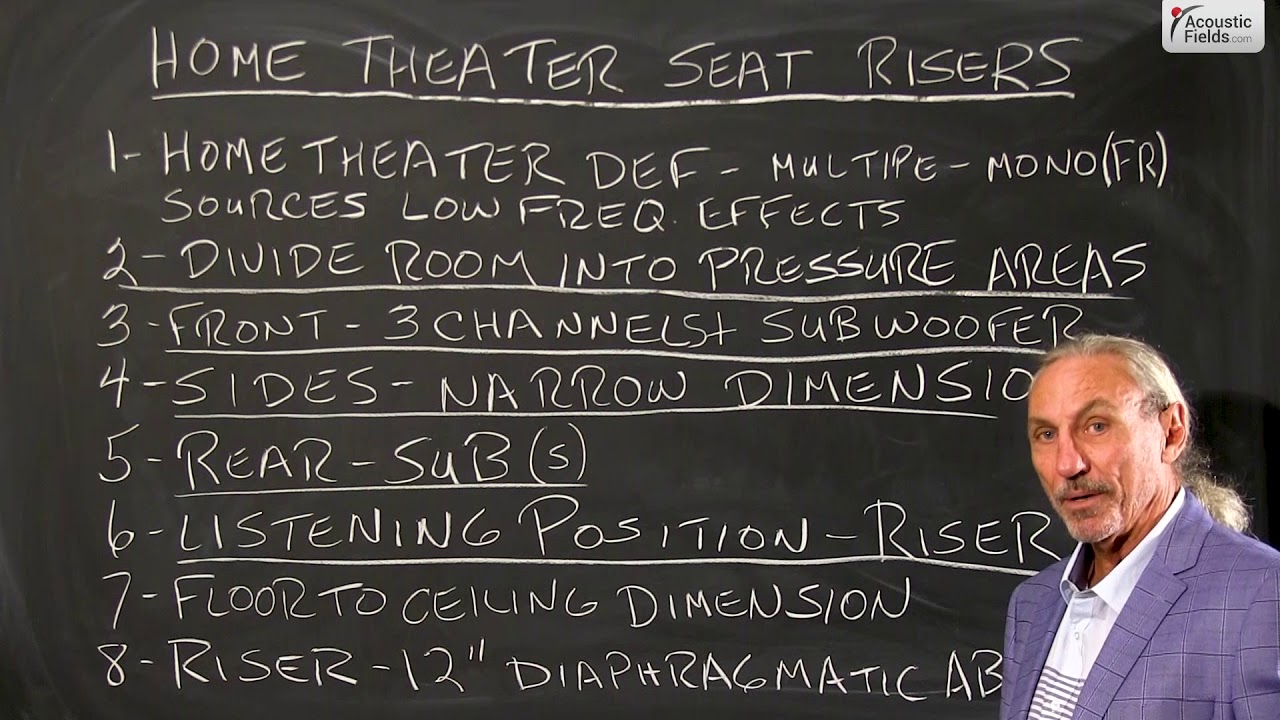Today we’re going to talk about home theater seat risers. We see a lot of room forms come in with home theaters and we see one row, maybe two rows, possibly 3 rows of seats. A couple of things going on there. Most of the time the back seats are never used.
So be very careful when you’re doing your planning and your room sizing and volume and speaker placement and all that and place everything so it works for the first row or the second row because we find that most people – in fact, in a lot of cases we actually remove the rear wall, the rear row of seating because it’s not used and on those rare occasions, holidays and stuff where you’re using it, you have more people there, just put in some temporary chairs. Because chairs are speakers so to speak. They create spurious reflections and we have to manage those, too. The less objects we have in the room, the easier it is to manage things.
So home theater. Let’s define it first. Because there’s a lot of misconceptions out there as there are with most things in physics but really it’s just a room with multiple model sources and low frequency drivers. So you have full range today that used to not be but today the sides and the rear channels are all full range.
So we have this box or this glass, if you will, and we have all these speakers which are water faucets and they’re all pouring water into the room and we’ve got to manage all that. Well, too many faucets, too small of a glass is usually the case. So when we’re managing the energy in the room, we want to divide the room up into pressure areas and look at those areas of the room that are causing the most pressure and then we can treat accordingly.
So the front, always an area of high pressure almost in any audio room. Why is that? Well, that’s where the sources are located. That’s where most sources are located. Especially in home theater we have center channels. We have left channel, we have right channel. So we’re not a big proponent of the center channel. We’ll do a video on that someday and show you how to get rid of that center channel and have a much better sound field. Okay?
So sides, usually in rooms, next to the ceiling and floor dimension, the sides of the room are one of the narrowest dimensions. So obviously narrow is bad when we’re trying to fill our room with water so to speak. And then the rear is an area that most people put subs. Okay, that’s good and depending on size and volume it may or may not be the best place for it.
Listening position, this is really what we can do to help ourselves because the floor to ceiling dimension is usually the smallest of the 3. So we have – when we’re introducing lots of subwoofers into a home theater room, we have excess pressure. And the excess pressure is in the floor to the ceiling dimension. And it’s through the whole room obviously because the ceiling and the floor run through the whole room.
So how do we work with this? Well, if our risers are at least 12 inches then we can build diaphragmatic absorption into the riser. And we do this in a lot of cases. So having low frequency absorption in a platform where you have your chairs is a great idea because obviously it’s good to minimize low frequency problems and issues right where you’re seated.
So the bottom line here is we can use that riser to our benefit. So a lot of you have built home theaters with risers and if you’re looking to increase the surface area for low frequency absorption, give us a call, we can help you with the diaphragmatic absorption process. For those of you with new design when you’re building a room from scratch this is an area that we want to definitely consider for low frequency management.
What we find in most small rooms, especially with home theater, you can’t have enough low frequency management. Because you have a lot of energy and you’re never going to be able to get it all managed to a smooth response curve but you could take some pretty big chunks out of it. So home theater seat riser, make sure you give that some consideration for low frequency absorption.
—
This is an unedited transcript from our video series from Acoustic Fields. There will be some errors in grammar and sentence structure that occur during this translation process.
For complete understanding and comprehension, please view the video which is included in this text. For any additional information regarding this topic or others relating to room acoustics, please contact us directly at:
P: 520 – 392 – 9486







